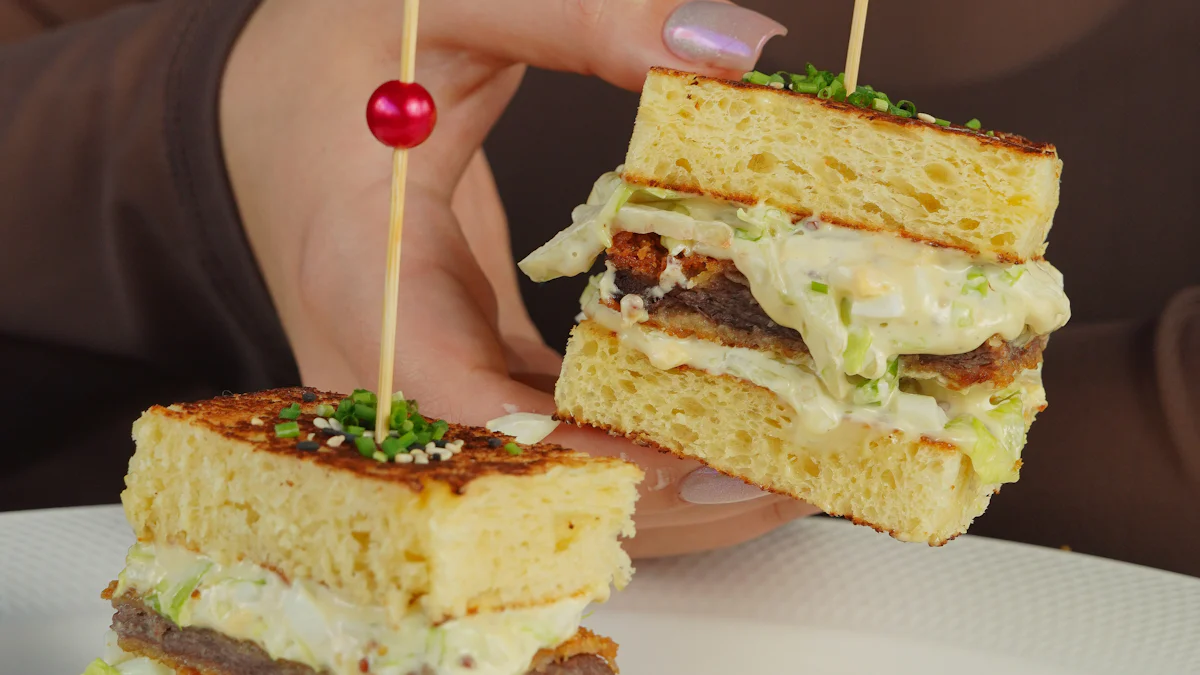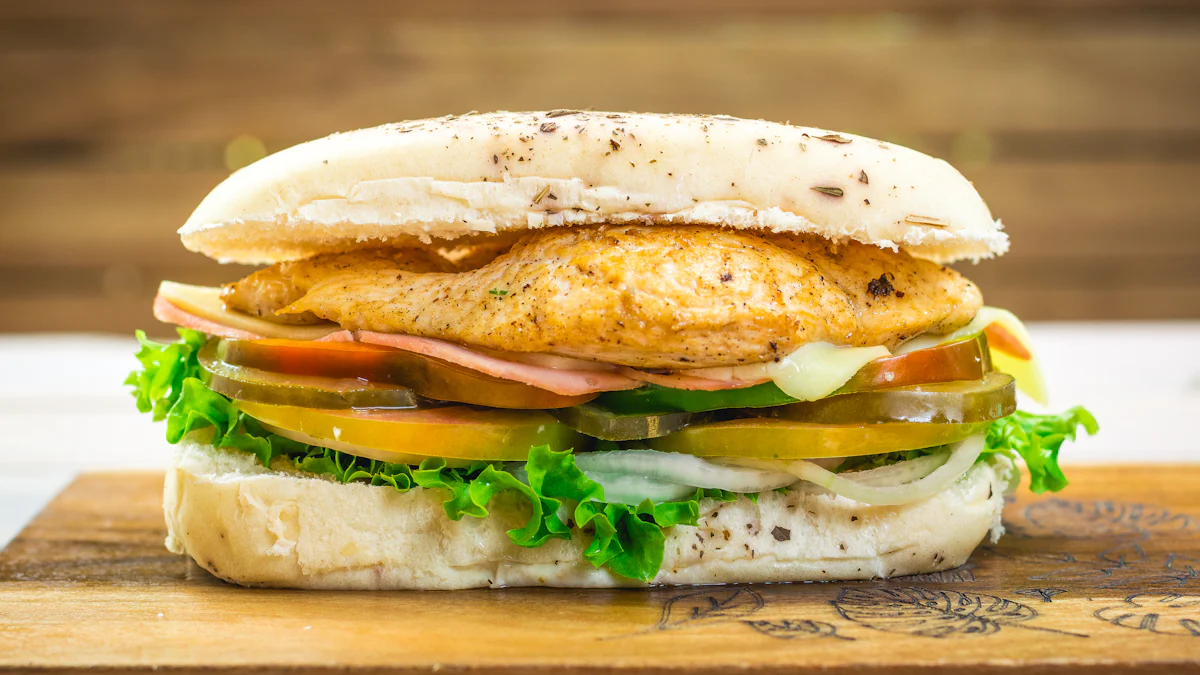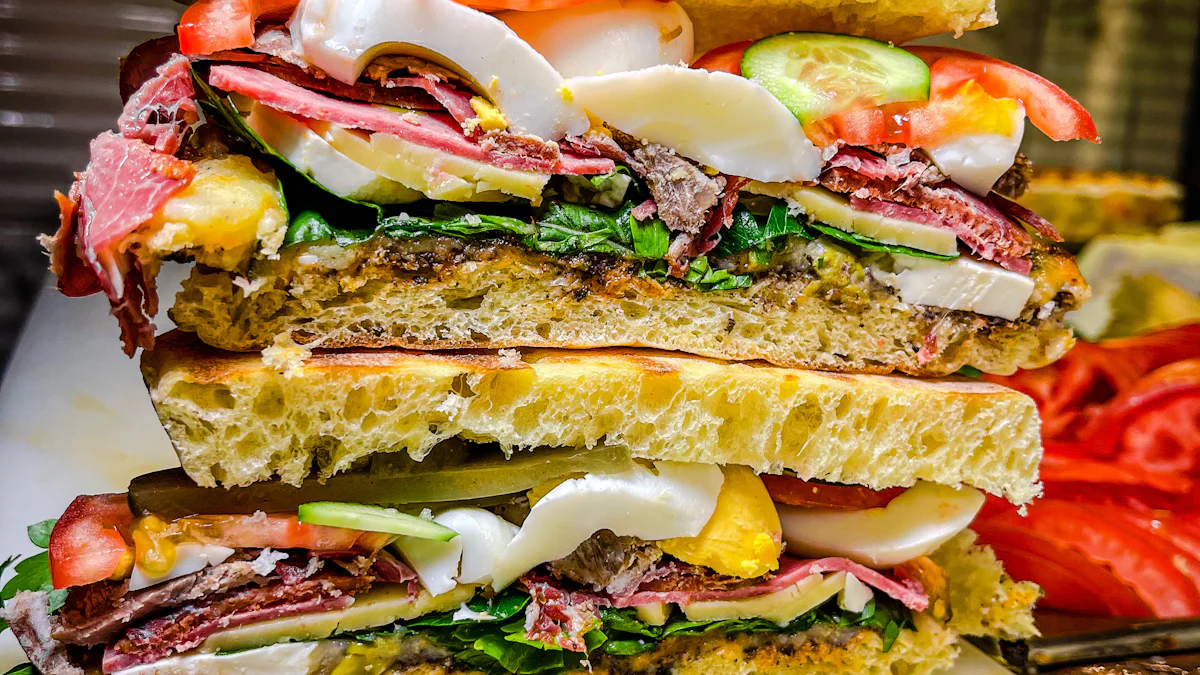
Creating the perfect sandwich is a delightful experience. You get to mix and match flavors, textures, and ingredients to craft something truly delicious. Sandwiches are a staple in many diets, with about 50% of Americans enjoying one every day. This popularity stems from their versatility and ease of preparation. Mastering the art of sandwich making not only elevates your meals but also brings joy to your kitchen adventures. Whether you’re using a Sandwich Maker or assembling by hand, the possibilities are endless. Dive into the world of sandwiches and discover the joy of crafting your own culinary masterpiece.
Key Takeaways
- Choose the right bread: Select bread types like sourdough or ciabatta to enhance flavor and texture.
- Balance your flavors: Combine sweet, salty, and savory ingredients for a well-rounded taste experience.
- Layer thoughtfully: Start with hearty ingredients at the bottom and use moisture barriers to prevent sogginess.
- Experiment with toppings: Get creative by adding unexpected ingredients like fruits or nuts for unique flavors.
- Utilize your Sandwich Maker: This tool simplifies the process, allowing even beginners to create delicious sandwiches with ease.
- Adjust to personal taste: Tailor your sandwich ingredients to suit your preferences, whether you like it spicy or mild.
- Use leftovers creatively: Transform last night’s dinner into a tasty sandwich filling for a quick and satisfying meal.
Choosing the Right Bread for Your Sandwich Maker

The foundation of any great sandwich lies in the bread you choose. With a Sandwich Maker, selecting the right bread can elevate your creation from ordinary to extraordinary. Let’s explore some options and tips to help you make the best choice.
Types of Bread
Sourdough, Whole Grain, and Ciabatta
Each type of bread brings its own unique flavor and texture to your sandwich. Sourdough offers a tangy taste with a chewy texture, making it perfect for robust fillings like grilled cheese or hearty meats. Whole grain bread adds a nutty richness, complementing stronger flavors and providing a nutritious boost. If you’re looking for something with a bit more bite, ciabatta is a great choice. Its airy interior and crisp crust make it ideal for sandwiches with juicy fillings.
When to Use Soft vs. Crusty Bread
Soft breads, like white or club bread, are excellent for delicate fillings such as egg salad or peanut butter and jelly. They provide a gentle cushion that doesn’t overpower the flavors. On the other hand, crusty breads like French baguette or focaccia are perfect for sandwiches with heavier ingredients. They hold up well under pressure and add a satisfying crunch.
Freshness Matters
How to Store Bread for Optimal Freshness
To keep your bread fresh, store it in a cool, dry place. A bread box or a paper bag works well, allowing the bread to breathe while preventing it from drying out. If you have extra bread, consider freezing it. Slice it first, so you can easily grab what you need without defrosting the entire loaf.
Signs of Stale Bread to Avoid
Stale bread can ruin a sandwich. Look out for signs like a hard texture, lack of aroma, or visible mold. If your bread feels dry or crumbly, it’s best to avoid using it. Fresh bread will always enhance the taste and texture of your sandwich.
Bread-to-Filling Ratios
Achieving the Perfect Balance
A well-balanced sandwich has the right amount of bread and filling. Too much bread can make it dry, while too much filling can make it messy. Aim for a ratio where the bread complements the filling without overpowering it. This balance ensures each bite is flavorful and satisfying.
Tips for Open-Faced Sandwiches
Open-faced sandwiches offer a creative twist. Use a sturdy bread like artisanal sourdough to support your toppings. Spread condiments evenly and layer ingredients thoughtfully. This approach not only prevents sogginess but also showcases the vibrant colors and textures of your ingredients.
Choosing the right bread is crucial when using a Sandwich Maker. It sets the stage for a delicious meal, allowing you to experiment with flavors and textures. Whether you prefer soft or crusty, fresh or toasted, the right bread can transform your sandwich-making experience.
Selecting Ingredients for Flavor and Texture
Creating a sandwich is like painting a masterpiece. You have a blank canvas and endless possibilities. The key to a delicious sandwich lies in the ingredients you choose. Let’s dive into how you can balance flavors and add creative toppings to make your sandwich truly stand out.
Balancing Flavors
A well-balanced sandwich tantalizes your taste buds with a mix of sweet, salty, and savory elements. Imagine biting into a sandwich where each flavor complements the other perfectly. You can achieve this by combining ingredients like honey-glazed ham with sharp cheddar cheese or adding a touch of sweetness with a slice of apple or pear.
Combining Sweet, Salty, and Savory Elements
- Sweet: Consider using ingredients like honey, fruit preserves, or even thin slices of fresh fruit. These add a delightful contrast to savory components.
- Salty: Cured meats, cheeses, and olives bring a savory depth to your sandwich. They enhance the overall flavor profile.
- Savory: Roasted vegetables, grilled meats, and hearty spreads like hummus or pesto can add richness and complexity.
Using Acidic Ingredients Like Pickles and Vinegar
Acidic ingredients can brighten up your sandwich. They cut through the richness and add a refreshing zing. Try adding pickles, a splash of vinegar, or even a squeeze of lemon juice. These elements can elevate your sandwich from good to great.
Creative Toppings
Toppings are where you can let your creativity shine. They add texture, color, and an extra layer of flavor to your sandwich. Don’t be afraid to experiment with different combinations.
Adding Crunch with Fresh Vegetables
Fresh vegetables not only add crunch but also boost the nutritional value of your sandwich. Consider adding lettuce, cucumbers, bell peppers, or sprouts. These ingredients provide a satisfying bite and a burst of freshness.
Incorporating Unexpected Ingredients Like Fruit or Nuts
Surprise your taste buds by incorporating unexpected ingredients. Try adding thinly sliced strawberries, apples, or even a handful of nuts like walnuts or almonds. These additions can create a unique flavor profile and add an interesting texture.
Expert Testimony: Owen Han, author of “Stacked: The Art of the Perfect Sandwich,” emphasizes that simple tricks can transform your sandwich-making experience. He suggests experimenting with different ingredients to find combinations that delight your palate.
Using a Sandwich Maker simplifies the process of creating these delightful combinations. With just a press of a button, even beginners can craft a delicious sandwich. By thoughtfully selecting your ingredients, you can quickly assemble a sandwich that’s both tasty and satisfying.
Preparation Techniques with Your Sandwich Maker

Creating a delicious sandwich involves more than just choosing the right ingredients. How you prepare and assemble your sandwich can make all the difference. Let’s explore some techniques to help you make the most of your Sandwich Maker.
Spreading and Layering
Evenly Spreading Condiments
Condiments are the unsung heroes of a great sandwich. They add moisture and flavor, ensuring each bite is satisfying. When using your Sandwich Maker, spread condiments like mayo, mustard, or butter evenly across the bread. This not only enhances taste but also acts as a barrier against sogginess. A thin, even layer ensures that every bite is flavorful without overwhelming the other ingredients.
Layering Ingredients for Optimal Taste
Layering is an art. Start with the heartiest ingredients, like meats or cheeses, closest to the bread. This provides a solid foundation. Next, add vegetables and other toppings. This order helps maintain the sandwich’s structure and ensures that flavors blend harmoniously. With a Sandwich Maker, this method allows for even cooking and a delightful texture.
Preventing Sogginess
Using Moisture Barriers Like Lettuce
No one likes a soggy sandwich. To prevent this, use moisture barriers. Lettuce, cheese, or deli meats can act as shields between wet ingredients and the bread. For example, place a layer of lettuce beneath juicy tomatoes or pickles. This simple trick keeps your sandwich fresh and crisp, even if you’re packing it for later.
Toasting Bread for Added Texture
Toasting your bread adds a delightful crunch and helps prevent sogginess. The heat from the Sandwich Maker crisps the bread’s surface, creating a barrier against moisture. Start with slightly drier bread for the best results. This technique not only enhances texture but also brings out the bread’s natural flavors. Plus, it gives your sandwich a warm, comforting feel.
Using a Sandwich Maker simplifies the sandwich-making process. With just a press of a button, you can achieve perfectly toasted bread and evenly cooked fillings. Even if you’re new to cooking, these techniques make it easy to create a delicious sandwich. By paying attention to spreading, layering, and moisture control, you can elevate your sandwich-making skills and enjoy a tasty meal every time.
Experimenting with Flavors and Textures
Personalizing Your Sandwich
Creating a sandwich is like crafting your own culinary adventure. You have the freedom to explore different cuisines and flavor profiles. Imagine adding a touch of Italian flair with pesto and mozzarella or going for a spicy kick with jalapeños and pepper jack cheese. The possibilities are endless, and you can tailor each sandwich to your taste.
Trying Different Cuisines and Flavor Profiles
- Italian Inspiration: Use ingredients like prosciutto, fresh basil, and sun-dried tomatoes. Add a drizzle of balsamic glaze for an authentic touch.
- Mexican Twist: Incorporate avocado, salsa, and black beans. A sprinkle of cilantro can elevate the flavors.
- Asian Fusion: Try using teriyaki chicken, pickled vegetables, and a dash of soy sauce. This combination offers a savory and tangy experience.
Adjusting Ingredients to Suit Personal Taste
You know your taste buds best. Adjust the ingredients to create a sandwich that suits your preferences. If you love spicy food, add more chili flakes or hot sauce. Prefer something milder? Opt for creamy cheeses and mild meats. The key is to experiment and find what makes your taste buds dance.
Innovative Combinations
Innovation in sandwich making means thinking outside the box. Pairing unexpected ingredients can lead to delightful surprises. Don’t be afraid to mix and match to discover new favorites.
Pairing Unexpected Ingredients
- Sweet and Savory: Combine turkey with cranberry sauce or ham with pineapple slices. These pairings create a delicious contrast.
- Crunch and Cream: Add potato chips or pretzels for crunch, paired with creamy spreads like aioli or tzatziki.
- Fruit and Cheese: Try apple slices with cheddar or figs with goat cheese. These combinations offer a unique blend of flavors.
Using Leftovers Creatively
Leftovers can be a treasure trove for sandwich making. Transform last night’s dinner into today’s lunch masterpiece.
- Roast Chicken: Shred it and mix with barbecue sauce for a quick pulled chicken sandwich.
- Grilled Vegetables: Layer them with hummus and feta for a Mediterranean-inspired delight.
- Pasta Salad: Use it as a filling with some fresh greens for a hearty sandwich.
Pro Tip: Experiment with different sauces like aioli, pepper jelly, or fruit chutney to enhance the taste of your sandwiches. These can add a burst of flavor and moisture, making each bite more enjoyable.
Using a Sandwich Maker simplifies the process. With just one button, you can start cooking, making it easy even for beginners. The Sandwich Maker allows you to quickly assemble and toast your creations, ensuring a delicious outcome every time. So go ahead, unleash your creativity, and enjoy the art of sandwich making!
You’ve now got the tools to craft the perfect sandwich. Remember these key tips: choose the right bread, balance flavors, and layer thoughtfully. Your Sandwich Maker simplifies the process—just one button starts cooking, making it easy even for beginners.
Pro Tip: Experiment with different ingredients and flavor profiles. Try new combinations of meats, veggies, and sauces. This creativity can transform a simple sandwich into a gourmet delight.
Enjoy the journey of sandwich making. Let your taste buds guide you, and have fun creating delicious masterpieces!
FAQ
How does a Sandwich Maker simplify the sandwich-making process?
A Sandwich Maker makes crafting sandwiches a breeze. You just need to assemble your ingredients, place them between slices of bread, and close the lid. With one button, you start cooking. The machine evenly toasts the bread and warms the fillings. Even if you’re new to cooking, this gadget helps you create delicious sandwiches with minimal effort.
What types of bread work best with a Sandwich Maker?
You can use various types of bread with a Sandwich Maker. Sourdough, whole grain, and ciabatta are popular choices. They hold up well under heat and provide a satisfying texture. Soft breads like white or club bread also work, especially for lighter fillings. Choose bread that complements your ingredients for the best results.
What are some tasty ingredient combinations for sandwiches?
Creating a delicious sandwich involves balancing flavors and textures. Here are some ideas:
- Bread: Sourdough, whole grain, ciabatta
- Meats: Turkey, ham, roast beef
- Vegetables: Lettuce, tomatoes, cucumbers
- Cheeses: Cheddar, mozzarella, Swiss
- Sauces: Mayo, mustard, pesto
Mix and match these ingredients to find your perfect combination.
How can I prevent my sandwich from becoming soggy?
To avoid sogginess, use moisture barriers. Place lettuce or cheese between wet ingredients and the bread. Toasting the bread also helps. It creates a crispy layer that keeps moisture out. These simple tricks ensure your sandwich stays fresh and delicious.
Can I use a Sandwich Maker for open-faced sandwiches?
Yes, you can make open-faced sandwiches with a Sandwich Maker. Use sturdy bread like artisanal sourdough. Spread condiments evenly and layer your toppings thoughtfully. This method prevents sogginess and highlights the vibrant colors and textures of your ingredients.
What are some creative toppings to add to my sandwich?
Get creative with your toppings. Add crunch with fresh vegetables like bell peppers or sprouts. Incorporate unexpected ingredients like fruit or nuts. Try thinly sliced strawberries or a handful of walnuts. These additions can elevate your sandwich and surprise your taste buds.
How do I achieve the perfect bread-to-filling ratio?
Balance is key. Aim for a ratio where the bread complements the filling without overpowering it. Too much bread can make the sandwich dry, while too much filling can make it messy. Experiment to find the right balance for your taste.
Can I use leftovers in my sandwiches?
Absolutely! Leftovers make great sandwich fillings. Shred roast chicken and mix with barbecue sauce for a quick pulled chicken sandwich. Layer grilled vegetables with hummus and feta for a Mediterranean twist. Using leftovers creatively can lead to delicious results.
What are some tips for spreading condiments evenly?
Spread condiments like mayo or mustard evenly across the bread. Use a knife or spatula for a thin, even layer. This ensures each bite is flavorful without overwhelming the other ingredients. Even spreading also acts as a barrier against sogginess.
How can I experiment with different cuisines in my sandwiches?
Explore different cuisines by using unique ingredients. For an Italian twist, try prosciutto, fresh basil, and sun-dried tomatoes. Add avocado, salsa, and black beans for a Mexican flair. Experimenting with different cuisines can make your sandwich-making experience exciting and diverse.

